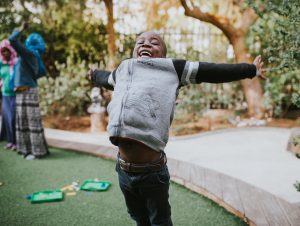This Boy is my Brother
By: Keyonna Murray
There’s a young boy in Northern New Jersey who was born in the mid-2000’s. With a bright smile and a contagious joy, he was always a person who brought some much-needed perspective to his family. In spite of this, it is an unfortunate reality that the world lacks understanding towards many individuals just like this boy. This boy is my brother, and April is the month to recognize the multitude of children who communicate, play, and develop similarly to him.

National Autism Awareness Month emerged out of widespread advocacy efforts started by Autism Society in 1970. Since its induction, the need for increased recognition has only grown, since today 1 in every 54 people in the United States has Autism Spectrum Disorder. In total, recent calculations say that about 1 percent of the world’s total population has autism.
In spite of how common Autism Spectrum Disorder actually is, understanding of it seems to be limited outside the advocacy realm or mental health discipline. However, this will likely continue to change as voices of both individuals with autism and experts within the field are fighting to rewrite long-standing narratives.
To give a bit more background, Autism Spectrum Disorder is defined as a neurodevelopmental condition. Common symptoms as listed by WebMD include:
- Difficulties in communication
- Speech/language delays
- Not using and/or responding to gestures
- Repetitive patterns of behavior
- Strong sensitivity to sight and/or sound
- Aggressive or challenging behavior
- Short attention span
This is a brief list of some major signs; that being said, it is important to keep in mind that autism is a spectrum, and as such can have very different manifestations in each individual.
The State of New Jersey has made strides in providing support to persons with autism and their families. As of October 2020, 1 in every 32 8-year-old child in the Garden State is recognized as being on the spectrum. However, only 81% of kids with ASD were said to have a documented case. Overtime, as more attention is brought to autism advocacy efforts, this will hopefully change. The New Jersey Department of Human Services also designed a comprehensive guide to understanding autism and the government-ordained services that are available; some examples of current policies include the Early Intervention and Title V programs as ordained as the NJ Department of Health, as well as the Division of Developmental Disabilities, which was started by the Department of Human Services to help fund support services. More information can be found in the guide.
The progress society has made in regards to constructing an environment accommodating to those with autism and other developmental disabilities could not have taken place without the consistent efforts of strong, dedicated advocates. In the attached video, I was able to hear about the mission firsthand from two team members of AutismNJ, a nonprofit organization dedicated to educating others about autism as well as providing resources and support for individuals and their loved ones. Dr. Suzanne Buchanan, the Executive Director of AutismNJ, and Mr. Eric Eberman, the Director of Public Policy at AutismNJ, both came to the interview with years of experience and a wealth of knowledge. As I spoke with them, I was made aware of just how multifaceted and policy-based the process of effective advocacy really is. The voice of passionate and credible experts truly is invaluable to furthering any important cause.
While AutismNJ is the organization represented in the video interview, they are not the only ones engaging thoroughly in this work; there are plenty of others that can be found in the resource list below this article.
April is a specific month that was chosen to highlight Autism Awareness efforts. However, this is something that will continue to require the involvement of career and volunteer advocates, support of the government, and willingness of every person to continue growing in their understanding. Right now, society still favors those who could be defined as neurotypical-and reversing this will likely take years to decades.
That being said, there is hope, and April is an annual reminder of that. And as the proud big sister of a sweet, loving, incredible, smart boy who also happens to have autism, I promise to keep learning and growing so I can learn how to be a better ally to him and so, so many others-and I hope that you, our reader and supporter, will as well.

About The Author: Keyonna Murray is a sophomore at Rider University who is studying Public Relations and Sociology. Driven by a passion for social justice and advocacy, she is determined to use writing to make her community a brighter one.
Categories
More Stories
- The Negative Impact Of The Government Shutdown
- Slacktivism: A Real Term for Unreal (Ineffective) Efforts
- The Hidden Cost of AI: Why It’s Not as Green as You Think
- Art as a Catalyst for Social Change: Harnessing Creativity for Advocacy
- Inspiring Change: A Step-By-Step Guide to A Campus Activism Event
- Advocacy Through Social Media: Extending Beyond Your Platform
- Unwrapping the Future: The Growth of Plastic Film Recycling

